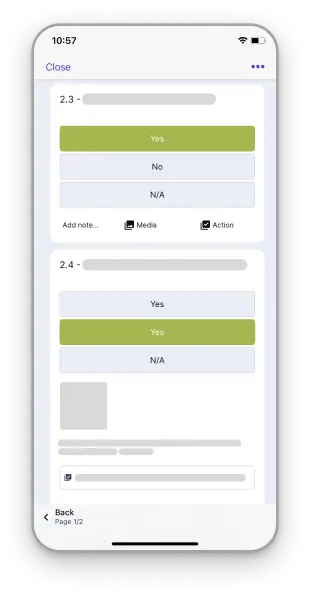What is a Machine Safety Checklist?
A machine safety checklist is a document for helping workers verify the safety of a workplace and its machinery. It can also help identify issues with machines, maintenance, and operations.
Importance
If you work with many machines, it is essential to have a machine safety checklist with you easily accessible. Maintaining and managing machine safety is critical in preventing accidents and injuries, as the consequences of a machine-related accident can be severe. According to the US Occupational Safety and Health Administration (OSHA), one of the most common injuries to look out for when working with machines are cuts, bruises, and, worst of all amputations, which can lead to lifelong issues and death.
Following this, a machine safety checklist also serves as a document that can be referred to for managing inventories, machine parts, injuries, and other important statistics. By properly documenting all machine issues and related injuries, it can be easier to manage budget allocation, perform risk assessments, and schedule maintenance checks.
Machine guarding is another essential aspect of machine safety that a dedicated machine safety checklist can help with. Guards and barriers can prevent workers from coming into contact with dangerous machine parts or moving equipment. A machine safety checklist can help ensure that materials are not likely to be ejected from machines and cause harm, as well as damage other machines or equipment that may be nearby.
Common Hazards to Look Out For
At workplaces where heavy machinery is used, there are a variety of potential hazards that employees may face. These hazards should be considered when making and filling out your machine safety checklist.
The most common hazards a machine safety checklist can help with are the following:
- Mechanical hazards
- Electrical hazards
- Chemical hazards
- Noise hazards
- Thermal hazards
What to Include in a Machine Safety Checklist
Your machine safety checklist can come in different forms. It can come in a multiple-selection or fill-out type depending on your needs.
Here is a list of items to include in your machine safety checklist:
List of identifiable equipment and machinery
Include a section to list down the machines and equipment you plan to use or inspect in your workplace. Doing so will help you conduct a more effective safety inspection, as identifying all the equipment and machinery in use can help you better estimate and address potential hazards.
Sections on potential hazards
This is for listing and documenting all the potential hazards associated with your machine. This section of your machine safety checklist should allow you to note everything from electrical to mechanical hazards and everything in between. Be sure to consider all possible threats and document them thoroughly. Then, assign them the proper risk level by evaluating the likelihood of an accident occurring and its potential severity.
Proper safety procedures to follow
Now that you have identified the potential hazards you might face, the next step is to develop and list down the proper safety procedures to follow for each one. This involves creating detailed instructions on how to use the equipment safely and identifying any additional safety equipment or personal protective equipment that may be necessary. It’s important to make sure these procedures are communicated clearly to all employees.
Once the machine safety checklist has been created, it’s important to conduct regular inspections to ensure that all equipment and machinery are in good working order and that all safety procedures are being followed. These inspections should be conducted at regular intervals, and any issues identified should be addressed immediately.
How to Use This Checklist
A machine safety checklist is often used during a machine inspection, preventive maintenance check, or equipment audit. This is how it is integrated into the common machine safety inspection:
- Step 1: Prepare for the audit — Before conducting an audit, you should identify the scope of the audit and prepare for it, which includes identifying the machinery that will be audited and the specific safety issues that will be addressed. After, it is time to create the machine safety checklist based on what has been identified. You should also review all documentation related to the machinery being audited, such as manuals and maintenance records, and consider them for your checklist.
- Step 2: Conduct the audit — As you conduct your machine audits, you should have your machine safety checklist with you at all times. Your checklist will guide you in how to perform an audit on your machines based on your identified needs and requirements. It would be best to use a digital checklist easily accessible on your phone or other devices as it would be easier to carry around and ensure that your documents are not lost or damaged.
- Step 3: Document findings — List down your observations from your audit on your checklist as you see them happen. With a digital checklist, you can easily and automatically save your findings as you write them down, ensuring no data on hazards, broken equipment, and safety compliance is lost.
- Step 4: Address hazards — After identifying the potential hazards, you should take steps to address them, such as repairing or replacing guards, adding safety devices, or modifying the machinery to eliminate hazards. However, if no immediate action can be taken, make sure to list down the proper actions to implement to solve the problems and inform the proper authorities to do them.
Here is a sample report of a filled-out machine safety checklist to show you how you can use it on the field:
FAQs about Machine Safety Checklists
Machine operators are the primary authorized personnel to issue, manage, and sign off on a machine safety checklist. However, in some cases, their supervisors and managers may also use the checklist as they see fit.
According to the Canadian Centre for Occupational Health and Safety (CCOHS), a machine safety checklist should be completed daily at the start of the work shift and whenever a certain machine or equipment is used. Depending on the situation, a machine safety inspection can also be conducted after a workplace shutdown if no changes were made. It’s also recommended to use checklists when doing machinery pre-start inspections.
For many countries, it is essential to conduct regular machine safety checks in certain workplaces. In these countries, there may be legal requirements for machine safety checklists or other safety documentation. It is important to research and comply with applicable regulations to ensure the safety of personnel and compliance with the law.




